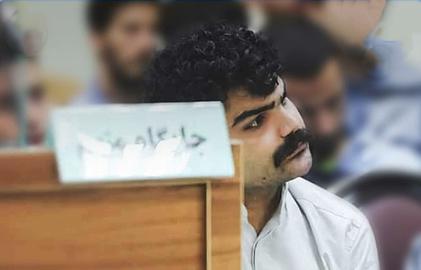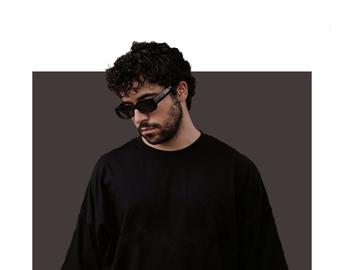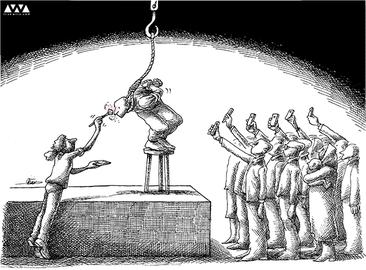
Delara Darabi (Left), Atefeh Rajabi Sahaaleh (Middle) and Behnoud Shojaee
Atefeh Sahaaleh was a psychologically unstable 16-years old student from the northern city of Neka. Police and morality authorities arrested numerous times for “indecent behavior” and the judiciary eventually sentenced her to death in August 2004.
After her execution it emerged that she was only 16, and that unlike other children, she had not even been given the chance spend a few years in prison trying to free herself. To avoid the condemnation of international human rights groups, judiciary officials later recorded her age as 22 in her case file, but her birth certificate, her identification card and her father say otherwise.
Atefeh's story reveals the brutal justice that Iran's legal system metes out to young people who are mentally ill or challenged by extreme life circumstances. Atefeh's mother died in an accident when she was five, and her brother, Javad, the only person who was close to her, drowned in a river shortly after their mother’s death. These two traumas upset Atefeh's mental balance, and the Office of Forensic Medicine’s documents show that she was suffering from “periodic insanity”.
A Struggling Family, a Judge Determined to Hang
The family was extremely poor, her father was a drug addict and a peddler of second-hand clothes unable to support Atefeh, who as a result constantly moved between social welfare care and the home of her disabled grandfather. She was first arrested for indecent behavior when she was 13. When she was 15, she was arrested for “adultery” although she had never been married and this charge only applies to married women.
During interrogation she told the judge that while in prison a 51-year-old married prison guard named Ali Darabi had repeatedly raped her. Authorities condemned the guard to 100 lashes but Atefeh was sentenced to death for adultery.
Throughout interrogation Atefeh clashed with the judge, Haji Rezai, and did not want to repent. She objected to the judicial system. But moments before her execution she asked people to forgive her.
What attracted the attention of human rights activists was the judge’s unusual insistence on the death penalty for Atefeh. To condemn her, Haji Rezai relied on certain bylaws that gave him the authority to apply the sentence. He travelled to Tehran to get approval from the Supreme Court and in less than one week returned to Neka with a signed authorization. He was present at the execution in the main square of town and, in front of foreign reporters, put the noose around her neck himself.
International media covered her execution extensively and members of her family were invited to the hanging. Her father later claimed that her grave had been desecrated and her body had been moved.
Atefeh, however, was not the first or the last young girl to be executed by the Islamic Republic. Mona Mahmudnizhad, a 17-year-old Baha’i girl, was hanged in 1983 a few years after the Islamic Revolution, because she was teaching Baha’i children about their faith. The list of children executed in the 1980s varies with the sources, but one of the known cases, Nafiseh Ashraf Jahani, was only 10.
Painter of Darkness
The artistic ambitions of one young girl on death row, Delara Darabi, attracted international attention in the late 2000s. Sentenced to death for murder at 17, Delara sought mercy and argued for her innocence through an unforgettable series of paintings that were exhibited at Tehran's Golestan Gallery. She had etched some of her paintings with fingers and fingernails because she did not have access to brushes and others materials inside the prison. Some of Delara’s paintings were later shown outside Iran, including at Berlin Tech, Germany. (A video about her paintings can be viewed on YouTube.)
The international outcry by human rights and children rights group, however, failed to sway the Iranian authorities, who hung her on May 1st, 2009. Until the last moment she insisted on her innocence.
Amir Hossein, Delara’s boyfriend, insisted that he had committed the murder and that Delara had only confessed to save him, since at the time of the crime she had been 17 and he 20; she had concluded that she would not face death penalty as an underage girl.
Amir Hossein’s persistence failed to convince the authorities, who ignored his statements, and two years after her execution he committed suicide. In the notes that he left behind he wrote that Delara had not committed the murder and that judicial authorities had threatened him repeatedly over his insistence that she was innocent.
Delara and Amir Hossein were said to have attempted robbery at the home of an elderly relative of Delara's father, and had ended up killing the old woman when the theft when awry. Her father took her to the judicial authorities himself, but later, in a video that was posted on YouTube, regretted his decision. He had not known, he said, that the justice system in Iran was so unjust; they had not even fingerprinted the knife at the crime scene.
The murdered woman’s next of kin placed conditions on forgiving Delara. One of the conditions was the dismissal of Abolsamad Khorramshahi, the defense lawyers. Khorramshahi had raised doubts about the verdict by arguing that Delara is left-handed while the wounds were inflicted by a right-handed person, as testified by forensic experts.
At the dawn of the execution day, when Delara was on her last phone call with her mother, a prison official grabbed the phone away from her hand and told her wailing and pleading mother that “we are going to hang her and there is nothing you can do about it”.
No Distinction Between Homicide and Murder
On October 11, 2009, about 200 children rights activists were gathered in front of the Evin prison in Tehran, reading Quran and praying for Behnoud Shojaee, a young man sentenced to death for killing a man in self-defense. Their prayers and the persistent efforts by Shojaee's lawyers, Mohammad Olyaeifard and Mohammad Mostafaei and artists such as Ezzatolah Entezami, Parviz Parastui and Kiumars Pourahmad proved futile. The victim’s mother pulled the stool from under Behnoud and he was hanged.
The Criminal Court had asked those three artists to stop supporting Behnoud since they “are supporting a murderer and want the public to turn a kind eye on him.”
“My client was unjustly sent to the scaffolding and was unjustly hanged,” said Mostafaei, one of his lawyers, in an interview with BBC.
“It is still not too late,” another lawyer told the victim’s family while Behnoud was still struggling. “I can bring him back with artificial respiration.” But the family would not consent. However, in interview with the Voice of America, the lawyer did not blame them. “It was not the victim's next of kin who killed Behnoud,” he said. “It was the Iranian Judiciary and their backwards laws.”
In 2005, when he was 17, Behnoud was attacked by a man in a street brawl. The man attacked him with a knife and he defended himself with a piece of broken glass. In his own defense, he stabbed the victim with the broken glass and the man was killed.
A Very Brief Respite
After Behnoud’s execution, from September 2011 to January 14, 2013, the authorities executed no children in Iran. Even in 2012, when the judiciary broke the record for the prior 15 years with 580 executions, children were spared, until the winter execution of Ali Naderi in January 2013.
When he was 17, Ali was arrested along with two other teenagers and charged with murdering an elderly relative. At the time of execution, he was 21. The United Nations Human Rights Council called it “shocking.”
According to Amnesty International, Iran, with 47 cases of child execution between 1994 and 2011, has one of the worst records in the world.
This reporter was unsuccessful in finding the number of children who currently face the death penalty in Iran. After repeated persistent questions an official of the Ministry of Justice told me that after the execution of Behnoud Shojaee and the pressures by international organizations, they are not allowed to divulge such information.
The Social Trauma of Death as Spectacle
Why Would You Attend a Hanging?
Put Death Penalty to a Referendum: an Interview with Emadeddin Baghi
"Since I resigned, I sleep better.”
The Value of Human Life: An Interview With Mohammad Mostafaei
The Most Disadvantaged Groups at Risk of Execution
Mohammad Mostafaei’s 10 Steps For Abolishing The Death Penalty
visit the accountability section
In this section of Iran Wire, you can contact the officials and launch your campaign for various problems

























comments